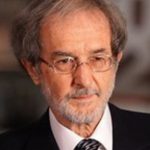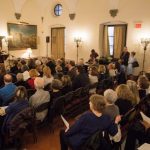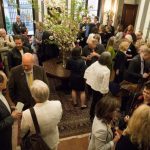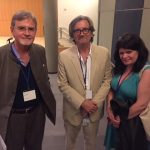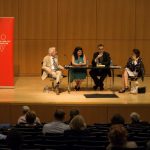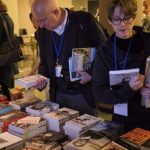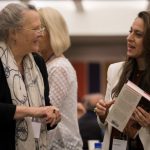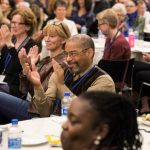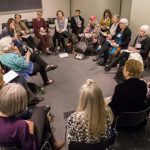⏴ Back to Past Confernces List
Thank you to everyone who participated in the Ninth Annual BIO Conference in New York!
You can see the program from the conference below.
Highlights
- Holmes Keynote Address and Husband-and-Wife Team in Conversation
Comparing Living and Dead Subjects
After opening remarks by new BIO president Cathy Curtis, the conference began Saturday morning with the breakfast plenary session featuring Edmund and Sylvia Jukes Morris. The husband-and-wife team titled their talk “Dead Is Easier,” referring to which kind of subject presents fewer challenges for a biographer. Edmund’s dead subject was Theodore Roosevelt, whose life he chronicled in a three-volume biography. Sylvia’s dead subject was Edith Kermit Roosevelt, TR’s second wife. Turning to the living, Edmund wrote an authorized if unconventional biography of Ronald Reagan, spending time with the president during his second term. Sylvia, meanwhile, had a close relationship with her living subject Clare Booth Luce—so close that at one point Sylvia joined Luce in her sprawling bed to watch television.- Sylvia Jukes Morris
- Edmund Morris
The title of the talk, Edmund recalled, came from years ago when a New York Times reporter asked him which challenge he preferred: writing about a living subject or a dead one. Before he could respond, Sylvia called out from another room, “Dead is easier.”
In the plenary session, the two authors spent some time talking about how writing about the death of their subjects—in Sylvia’s case, Luce died while the author was still writing about her—affected them. While saying that he probably would not have liked Roosevelt when alive, given Theodore’s “bloodlust” and “bellicosity,” Edmund said that when it came time to write about the president’s death he felt a sense of bereavement. For her part, Sylvia cried as she wrote about Edith Kermit Roosevelt’s death. And the death of Luce, which happened after she and Sylvia had known each other for seven years, stirred different thoughts and feelings for the biographer. Sylvia explained: “I felt a thud in the chest, which was probably a combination of shock, grief, and apprehension; what should I do now about all the unanswered biographical questions?”
Edmund also had a long relationship with his living subject, Reagan, agreeing to write a life story about him in 1985. During the president’s years in the White House, his dementia was not apparent, Edmund said. Reading the 1993 letter in which Reagan publicly revealed his struggles, Edmund said he was filled with “overpowering sadness.” But that, he said, “quickly evaporated.” His writing of the Reagan book was still to come, and Edmund felt a need to accept what he called the “biographer’s challenge,” which he framed in the words of W. B. Yeats: “Cast a cold eye on life, on death.” Otherwise, Edmund thought, his book on Reagan would become sentimental “and consequently, untrustworthy.”
Spending time with his living subject, Edmund said, led him to appreciate Reagan’s sense of humor and the intelligence behind it. It also led Edmund to become a teacher of sorts to the president. When the two visited Reagan’s birthplace of Tampico, Illinois, after Reagan’s dementia took hold, the biographer had to point out the significance of buildings they saw. Edmund said, “I was instructing him in his own life.” Like other biographers, he came to know more about his subject’s life than his subject did.
Edmund had a different kind of intimacy with his dead subject and his family. While doing research at Roosevelt’s home in Oyster Bay, New York, he found an envelope that contained a lock of hair from Roosevelt’s first wife, Alice. While fingering the hair, he felt a “creepy connection” to her. Edmund was particularly attracted to the love story of Alice and Theodore, and he felt a certain sense of anticipation when he reached the spot in the president’s diaries that led to his wedding night. Roosevelt left out details of the evening; Edmund assumed he did so knowing that some “beady-eyed biographer” would one day read the diary.
For Sylvia, one of the thrills of researching Edith Roosevelt’s life came when she read four letters TR had written to her. Before that, Sylvia said, she was “frustrated by a lack of information about Edith’s emotional life,” as she didn’t keep a diary. Sylvia learned that Edith had burned the correspondence between herself and her husband—except for the four letters that one of Edith’s daughters had convinced her to save. The letters gave Sylvia a sense of their private relationship.
Offering some general observations on biographers and their craft, Edmund stated that biographers should feel “the responsibility to resurrect the vital reality of the past.” And when it comes to dealing with the death of a biographer’s living subject, he suggested that a biographer embrace this dictum: “First, kill the widow.” That will eliminate her impulse to withhold disparaging information, Edmund explained. Another issue when dealing with an elderly subject is that their contemporaries are aging as well, which can present challenges when trying to question them for useful information.
Although both Sylvia and Edmund Morris had positive experiences writing about the living and the dead, Edmund concluded the session this way: “Alive or dead, biography is never easy.”

Richard Holmes laced his address with humorous anecdotes while exploring different elements of the biographer’s craft.
Photo by Jane O’ConnorHolmes Shares “Biographical Parables”
For Saturday’s keynote address, Richard Holmes offered what he called parables for biographers, based on notes he had taken during his career that reflected his research and writing experiences (and filled more than 200 notebooks). The first parable Holmes called “Touchstones.” He quoted W. Somerset Maugham, who said, “There are three rules for writing biography; unfortunately, no one has discovered what they are.” Noting flexibility of biography as a genre when it comes to form or subjects, Holmes said, “there are no rules in that sense.” On the matter of subjects, he recalled the words of Samuel Johnson, who asserted “I could write the life of a broomstick.” Holmes also noted that everyone doesn’t necessarily have a warm spot in their heart for biographers; James Joyce once referred to them as “biografiends.”Holmes called his second parable “Passports,” and he told the story of indicating his occupation on a passport as “writer” and a French inn owner interpreting it as “waiter.” As Holmes made adjustments and further misunderstandings ensued, he was finally accused of being a “table waiter with delusions of grandeur.” His larger point amidst the humor was that biographers needs humility, and they are waiters of a sort. They attend to their subjects and offer them “loyalty, patience, good humor, but not discretion. And usually, you have to clear up some kind of mess as you go along. And above all, you are not more important than your subject.” Holmes said one essential trait for biographers is “the rather strange ability to fall in love with your subject, then out of love again, as is necessary.”
Holmes went on to talk about how chance comes into play while doing research, as finding useful sources can sometimes come down to luck or someone’s whim. When looking at a subject’s private life, the facts can be especially hard to find. Holmes believes there is no such thing as a definitive biography and, he explained, biographers do not work in a vacuum—an idea reflected in a tale he told about researching the life of Samuel Taylor Coleridge. Holmes found a cave in which the poet had carved his initials into the sandstone walls. Holmes realized that given the soft nature of the rock, the original initials could not have lasted over the centuries. Biographers before Holmes had found the cave and re-carved the initials. This re-carving by “unknown memorialists,” Holmes said, “was a symbol of the essentially cumulative practice of biography itself.”
In a parable he called “Range,” Holmes described the range of students who attended the MA program in biography and creative nonfiction that he established at the University of East Anglia. In age they spanned 21 to 71, and they came from various socioeconomic backgrounds and different countries. The students were exposed to people and circumstances they might not have otherwise experienced. Biography in general, Holmes said, “provides another time, another place, another identity.” Writing a biography lets an author step out of their own life, “and that stepping out of your own life allows you eventually to look back at your life.”
Holmes also discussed the importance of the first sentence in setting the tone and theme of a biography, citing several examples. One was from his biography of Percy Bysshe Shelley: “His bedroom window looked west, towards the setting sun.” The simple line foreshadowed, among other things, Shelley’s drowning death caused by a storm that came from the west as sunset approached. Holmes also read the first line from Robert Caro’s biography of Lyndon Johnson, which described an anecdote the president liked to tell about the announcement of his birth. The line showed both Johnson’s penchant for telling tall tales and his sense that he was destined for greatness.
After finishing his parables, Holmes offered some closing thoughts on the skills and traits a good biographer needs. He framed it with the metaphor of a telescope and the person who peers through it. A telescope brings distant objects close, sometimes revealing the lesser stars. Using a telescope “requires patient observation, it needs timely adjustment, it keeps you up all night, and above all it requires a steady hand.” Holmes concluded with another metaphor, calling biography “a handshake across time, across cultures, across beliefs. . . .” And, he added, a handshake is also a symbol of honor and keeping one’s word.
- Conference Panel - What to Leave In, What to Leave Out
Moderator William Souder began the session by asking questions he has asked himself: “What compels the reader to stick with the story that I’m telling;” and after doing his research, “How to deploy the research in service of the story.” Implicit in the second question was the topic of the panel. Souder then had each panelist describe their experiences and how they choose what to include and exclude to serve the stories they tell.
Anne Heller has written both a short biography, of Hannah Arendt, and a much longer one, of Ayn Rand. She used a metaphor to describe the difference between writing a long magazine profile or short biography versus a longer biography. The writing [of] the former, she said, is “a little like [creating] a ship in a bottle.” You need to show the shape of the ship, but you don’t have to provide the details and structure that would be necessary to build an actual seagoing ship or a full-length biography.
For her Arendt book, Heller said, she had to omit many details of her subject’s life that didn’t fit with the main theme she was developing. With the Rand book, she did research in newly available Russian archives and, she said, “I didn’t want to leave out anything that I had discovered.”
With her subject William Fox, Vanda Krefft ended up writing a much longer biography than she anticipated. Her book was the first on the life of the filmmaking pioneer, and she wanted to make sure Fox got the credit he deserved for his impact on the industry. Krefft also felt a need to provide context for the events of the era during Fox’s life (1879–1952). But while providing that context or dealing with tangential characters, she tried to follow this rule: “Never go more than three paragraphs without coming back to your subject.” In one case, that meant cutting out interesting information about someone in Fox’s life.
Krefft also knew she had to confront a black mark on Fox’s reputation: his conviction in 1942 for bribery and perjury. She came to believe that a negative action late in a person’s life doesn’t undercut their earlier accomplishments. A negative action can also spur the biographer to consider whether something happened to trigger a subject’s transgression, or was there something in their character that was always there that led to it.
Claudia Roth Pierpont faced a similar issue when writing about Eudora Welty. Pierpont has specialized in writing long profiles for The New Yorker, though the definition of long has decidedly shrunk over the years. Initially, she was told, “make it as long as it needs to be,” and some of her profiles reached 13,000 words. Now, the typical length is half that.
With her Welty piece, Pierpont’s research led her to believe, and write, that Welty had racist tendencies, at least later in her life. Pierpont thought there might have been even more in that vein that she didn’t find. Pierpont said “it was hard to decide” to include the element of racism she uncovered and the reaction against it was strong. Still, she didn’t change her mind about her interpretation of Welty’s character, and in the end she believed that Welty was a more complicated figure than people might have thought, because of her later racist attitudes.
Heller made a similar point about her two subjects, saying both could be cruel towards their critics. But the unflattering material a biographer uncovers can help reveal a subject’s true essence, and for her with Arendt, something Heller considered anomalous in her subject’s character provided an “opportunity to think anew” about the story she was telling.
In the Q&A at the end of the session, Vanda Krefft noted that in the archives biographers rarely have time to read everything. Thankfully, most institutions now allow researchers to photograph material, which she did in order to read everything later. When there are gaps in the research on a subject’s life, Krefft said, biographers can turn to the papers of people the subject knew, or simply compress the time periods for which there aren’t good sources. Pierpont said biographers could even skip those periods for which there are archival gaps.
On a question about an appropriate length of quotes, Heller said she wants to hear the subject’s voice, but not at the expense of the narrator’s. In general, she favors short quotes and reminded authors to consider fair use when choosing to quote long selections.
Due to technical difficulties, the transcript of the recording of this session was not complete. TBC apologizes to the participants.
- Conference Panel - Biography and the Arts
Heath Lee moderated this panel, which featured four writers who have written biographies about figures from four distinct artistic fields: classical music, the visual arts, popular music, and dance.
Cathy Curtis, who has written books about two painters and is working on a third, discussed some of the topics biographers should keep in mind before tackling a book about a visual artist. Consider the audience, she said, realizing that many readers may not be steeped in artistic terminology. She avoids it, saying, “I think it’s alienating.” She also said she does not place much emphasis on analyzing individual pieces of art, preferring to make the subject’s life her focus.
Images of art, though, are necessary for a biography of a visual artist, and here Curtis had some bad news. Getting the rights to publish a single image can cost hundreds of dollars—money that comes out of the writer’s advance, not from the publisher. In her contracts, Curtis asks for money beyond the advance to help pay for images. Tracking down images can also be time consuming, and at times frustrating, if a biographer is dealing with the private owner of a work, rather than an institution. The private owners might not understand the need for a high-quality image, not a picture of the piece they take with their own camera.
Another piece of advice Curtis had for those authors thinking about writing a biography of an artist: pick someone famous. That increases the odds of making money on the book.
Anthony Tommasini, the chief classical music critic at the New York Times, wrote a biography of composer Virgil Thomson just over 20 years ago and is currently working on a book meant to be his personal “guide” to the music of major composers. The latter will have some biographical elements. In general, he said, classical musicians are not often popular subjects for biographies. But with his Thomson book, Tommasini was convinced that he had a fascinating life to explore, given the composer’s interaction with other artists, movements, and a gay culture then still largely closeted.
Looking at practical matters, Tommasini agreed with Curtis on avoiding terms particular to the art. Even the most basic musical terms may confuse general readers. But as a critic first, he said he thought analyzing the work of the subject is important. He advised trying to say something about a composer or musician that both scholars and a general audience will find interesting. To help that, he explained, choose a subject who crafted a particularly captivating persona.
For rock critic Anthony DeCurtis, the subject of his latest book certainly fit that criteria. Lou Reed created a persona that he sometimes referred to in the third person, and that changed over time during his long career as one of rock’s most influential writers. “Unpacking that [persona] was the key to the book,” DeCurtis said. He tried to explain how Reed created his public image, how he used it, and what was true to who he really was.
For DeCurtis, who has a PhD in literature, his Reed biography was a mixture of reporting and criticism. And because Reed wrote about his life in his songs, his music and his biography are intertwined. DeCurtis knew Reed and they got along well, despite the musician’s disdain for critics. But DeCurtis was sure that had Reed not died in 2013, he would not have wanted DeCurtis or anyone else to write his biography, and he would have discouraged friends from cooperating.
Offering tips to biographers who want to write successful books about pop culture figures, DeCurtis said it’s easier to get a good advance “if you’re writing about a famous rock star who just died.” He suggested that writers have a trusted reader give feedback on the manuscript, and to use biographies that “work the way you want yours to work” as models. (DeCurtis used James Atlas’s biography of Delmore Schwartz—Reed’s literary mentor—as his model.) DeCurtis said it helps to deeply believe in your subject’s artistic output; it helps a biographer grapple with more challenging aspects of the subject’s life.
Elizabeth Kendall has focused on dance in her biographical works, having written one biography of George Balanchine and is working on another. She began her writing career as a dance critic, and her knowledge of Russian gave her access to information about the choreographer in Russian archives. Unlike writing about other art forms, she said, dance is “especially mysterious” for many people, in part because it’s largely not taught in schools and “people don’t understand it.” Writing about dance can be challenging, since there is nothing that can be reproduced in a book that represents “the dance” as audiences experience it.
Kendall said biographers of artists should choose a subject they deeply care about, and should feel a strong connection with both that person and his or her art form. When writing, biographers need to figure out “how much of the work do you put into the life . . . [and] how much does the description of the work further the plot.”
Perhaps even more important, Kendall said, biographers need to take the pieces of their subject’s life, “the scenes,” and create the story, which is guided by the writer’s own sensibilities.
- Conference Panel - Biography: The Ultimate Interdisciplinary Approach
Moderator Billy Tooma, panelists Rebecca Williams and Tony Calandrillo, and several audience members all agreed [that] biographies can be useful tools to teach a variety of subjects at the college level, from literature to physics. Tooma began the session by quoting Walter Isaacson, from his recent biography of Leonardo da Vinci, stating that making connections across disciplines, as da Vinci did, “is a key to innovation, insight, and genius.”
The panel was part of an “exchange program,” initiated by Tooma and former BIO president Will Swift, between BIO and the Community College Humanities Association (CCHA). Tooma serves as the latter’s deputy executive director. In November 2017, four BIO board members took part in a panel at the CCHA’s annual conference.
Williams, a professor of English at Essex Community College, said she often uses biographical material in her literatures classes, especially ones focusing on African American and women’s literature. She noted that black authors of the past sometimes wrote biographies of other black writers. With women authors, reading biographies of their lives can help students understand the circumstances they confronted as they pursued their writing. Biographies in general, Williams said, give students a broader understanding of the culture that influenced fiction writers. Looking beyond her own field, Williams suggested that biographies, including ones written for the Young Adult market, can be a way to stimulate students’ interests in the STEM fields. For example, she said, “civil engineers should read The Power Broker.”
Calandrillo, a doctoral candidate at Drew University, drew on personal experience to illuminate his idea that biography can humanize the social sciences. International relations was his first academic subject, but he felt most scholars in the field stressed quantification over people when doing their research. In his dissertation, Calandrillo set out to explore a facet of U.S. international relations through the story of Albert Spaulding, the sporting goods manufacturer who helped bring baseball to the world. Spaulding had his economic interests in mind, but the barnstorming tour he sponsored also served as a facet of “soft power” diplomacy during the late nineteenth century. Echoing Williams, Calandrillo said that in the classroom, biography can explain not only the subjects at hand but the processes behind them. Biographies also show students the real people behind important events, highlighting both their strengths and flaws.
The panelists, joined by audience member Nigel Hamilton, a historian of biography, looked at some of the factors that keep biography out of many classrooms. Calandrillo said he believed the PhD system was partly responsible for the largely negative view of biography in academia. Hamilton wondered if professors feel that by using biography as a text they are promoting a particular figure. He said the teachers need to see that biography is not hagiography, and biographical slice-of-life books can have a place in the classroom.
The panelists agreed that biographies can be “correctives” to the standard textbooks used in many college classrooms. Tooma noted that Plutarch’s Lives was once a “textbook” for teaching history. He also said that a biography’s emphasis on narrative can capture students’ interests in a way most textbooks don’t. Calandrillo said biographies “can fill in the rest of the story” when a textbook has gaps. Biographical documentaries can play the same role: Tooma said they can “enhance, humanize, and correct” written sources. Williams said episodes of PBS’s American Masters are particularly useful in the classroom.
- Conference Panel - New Wrinkles in Literary Law
Kirk Schroeder, an attorney who specializes in entertainment and the arts, warned his audience: “There’s always something in a book, particularly nonfiction that can arise and surprise an author.” One issue that can bedevil biographers is fair use. Schroeder noted that what constitutes fair use often “comes back to haunt you.” Fair use applies to how much a writer can use from a copyrighted work without seeking permission from the copyright holder. Material created before 1923 is no longer under copyright. Copyright protection in the United States lasts for 95 years, and it encompasses a large body of work.
Fellow panelist Eric Rayman, whose practice focuses on media, publishing, and copyright, examined some ways biographers can avoid pitfalls, snares, and traps in a project. He said there is great value in having subjects sign releases, although they are not necessarily required. “At least make sure there is a written record of the conversation.” If using a recording device (including phones), biographers should say that up front, although not all states require that all parties consent. Rayman said, “It can help you,” if push comes to shove, over what was said or the biographer’s right to use. As to “oral promises” to allow the use of a conversation or anything else, Rayman said, “I’d think they can be retracted,” while a written agreement cannot. In short, “a retraction can make trouble for you.”
Moderator Diane Kiesel asked Schroeder about access to materials and intellectual property rights regarding materials given to you but not created by the subject. He then asked a rhetorical question: “What about photos that came from a professional photographer and are now in the possession of the subject?” Can the subject legally hand those images to the writer for his or her use? “They might be in the public domain,” Schroeder said, but that is not guaranteed. So, depending on when the image was made and the applicable copyright statute, “this means you have to get the permission of the photographer. . . . Just because someone gave you the photo, doesn’t mean you have permission to publish.”
If the permission issue or any other issue ends up in court, Schroeder said who pays for the biographer’s legal representation depends upon how the contract is written. Any agreement on the part of the publisher to cover possible legal costs “will go against the advance,” if there is any, “to get an insurance policy.” But even in this arrangement, Schroeder said the insurer may stipulate that the policy does not cover certain points that can lead to lawsuits.
Considering libel, Rayman said, “Truth is a defense.” Regarding what can be written about public officials and public figures, the standing Supreme Court decision is New York Times Co. v. Sullivan (1964). The court unanimously ruled in that decision, which has since been extended to “public figures,” that the plaintiff has to show that the material was defamatory and that the publication or broadcast was done with actual malice and with a reckless disregard for the facts. Both panelists noted, however, that the definition of “public figure” is not clear cut.
Given the broad American defense in these libel cases for writers and publishers, Rayman noted that “libel tourism” has become a way for plaintiffs to seek legal recourse. By going to a judicial system operating under British Common Law, e.g., the United Kingdom and the Commonwealth of Nations, they could bring suit and often win. There is no “actual malice” defense in that system.
Both panelists said that consulting an attorney who specializes in libel or other issues related to publishing isn’t always necessary before entering an agreement with an agent or a publisher. But, Rayman said, “If you’re not sure . . . you might need a lawyer” and not one who handles real estate or family matters, but a specialist.
—John Grady
- Conference Panel - Telling Life Stories
Editors are looking for story-driven, character-driven works to appeal to a biography-buying public, said Laurie Gwen Shapiro, author of The Stowaway: A Young Man’s Extraordinary Adventure to Antarctica. “Taking a large story and [then] taking it down to a story within a story [is] very sellable,” she said, adding, “old archives aren’t enough.”
Sharing their thoughts on useful storytelling techniques were Alan Pell Crawford, author of How Not to Get Rich: The Financial Misadventures of Mark Twain, and John Matteson, whose most recent work is The Lives of Margaret Fuller. Moderator for the session was Anne Boyd Rioux.
“Almost all literature is biography about an individual or a group,” said Crawford. When looking at biography that way, it “is narrative nonfiction.” Visual images can play an important role in advancing the narrative. Crawford said, “You have to dig for it, use every sense to dig up this lost world” of the subject. He cited Leo Tolstoy’s technique of grabbing readers “with an actual sense [of] being there” at the start of each chapter in his novels.
Travel can be essential to capturing that sense of being there. “I believe in going to the place,” Matteson said. “I walked everywhere,” using a watch to time how long it took to get from place to place. While this gives a three-dimensional approach to the research, he warned, “flora and fauna can change over time.” What the researcher is experiencing is not necessarily the same thing the subject experienced. “Places change,” he added. In Shapiro’s case, she took an Antarctic voyage to get that sense of place, “but not as an Antarctic explorer.” She was following in her subject Billy Gawronski’s footsteps.
While Shapiro said she approaches a book as writing something she wants to read, Matteson said the character, subject, or book “maybe in a way chooses you.” In his case, he said, “sit me down with some letter, some diaries, [and] I can tell you a story,” and that can lead to a book.
When approaching a new book, Matteson said, “sometimes, you want to boil [it] down to one word.” Then, when writing, the biographer “bring[s] it back to that core” until reaching the end.
The panel warned against “embroidering” a scene or speech for effect, as a novelist can. “You need to get rid of that,” Crawford said. Matteson quoted Stacy Schiff’s reminder to biographers that they are novelists under oath. That means “choosing the right material,” Shapiro said. The final product is the “tip of the iceberg” from the research, the panelists said.
The panelists highlighted other concerns beyond embroidering. For instance, Crawford said, “Anachronistic terms offend me as a reader. . . . They get in the way of their own story.” Matteson reads his story back to himself to gauge its pace. He also said biographers should remember that while themes in a book can be complex, chronological order makes it easier for both the writer and reader to follow the narrative. Shapiro said she asks herself, “Is what I’m writing worthy of a book?” and listens to people who are critiquing the work as it progresses.
The word “humility” was also used regularly during the give-and-take discussion. “You’re probably not going to be a legend yourself,” said Matteson. Remember, he said, that readers will likely be buying the book because of the subject. But he also encouraged biographers to “let your genius out.” In answering an earlier question, he reminded the audience: “you are turning other people’s pain” into art when using the techniques of narrative nonfiction.
—John Grady
- Conference Panel - The Soul of a Biographer
Although Percy Bysshe Shelley attended Cambridge and might have been expected to be recognized as a talent of his era, the poet was not well respected at his alma mater years after his death and was almost forgotten. But it was reading one of Shelley’s poems, “on a wet afternoon in a laundromat,” that set 2018 BIO Award-winner, Richard Holmes, off on his odyssey of writing Shelley: The Pursuit, starting his career as a biographer.
In a conversation with James Atlas, Holmes said that his own journey was made somewhat easier because he “inherited a folding company bed” used by the British military, so he had something to sleep on as he journeyed into another’s life.
Holmes said it was important to him to follow in Shelley’s footsteps, and later Coleridge’s and others, to have a better understanding of them as people and the world they inhabited. But, he added, that physical pursuit may not yield the expected results. In researching Robert Louis Stevenson, Holmes came upon a bridge that he thought Stevenson had crossed and written about. “I think I’m going to meet Stevenson,” he thought in crossing. But off in the distance, he finally noticed the original bridge, closed to traffic. Holmes realized, “I can’t do this”—meet Stevenson in this way. “The bridge is always broken.”
Holmes’s took away two important lessons from the Shelley and Stevenson experiences: “you only discovered what you have written after writing” and “accept what you don’t know.”
Atlas, describing his experience of dealing with novelist Saul Bellow as a living subject, said, “Dead is probably easier than Bellow.” On writing about a living character, he said, “I wouldn’t do that again.” Atlas added, “The more time I spent on [Bellow] I felt the less I knew him.”
After reading a section of Atlas’s Bellow: A Biography, Holmes said both writers “share a wonderful eye for detail” and the exchanges between the subject and biographer were telling about them as individuals and as author and subject.
Discussing his research process, Holmes described how he always takes notes in a notebook that is divided into right- and left-hand sides. The right is for facts and figures, while the left is for “your dreams,” he explained. And, “complex emotions should be included,” as they can provide the images used in writing.
Speaking from his experience as an educator in the United Kingdom, Holmes said it was important for biographers to differentiate between sympathy and empathy when examining and then writing about a person. Often, he said, “you fall in love with your subject and [later] fall out of love with him.” In short, the writer has to “start stepping back” to address the person as the subject.
Like other biographers, Holmes added, “you [can] learn a lot through journals” and notebooks kept by the subject that go beyond the words on paper. In the case of Samuel Taylor Coleridge, Holmes’s research included facts, figures, dates, places, people, and even where Coleridge revealed a sense of humor through his tone of voice. “When he’s taking a lot of drugs, his writing gets large, vivid,” said Holmes.
As the session neared its end, Holmes returned to Shelley as a subject. He concluded, “I think the figurative is the allegory of life” and the writer needs to be aware of that in the work as a whole.”
In looking at the breadth of a work and how each scene or chapter comes together as a whole, Atlas said, “Footnotes are high on the list [because] I didn’t ever want to ruin the narrative [and its] forward propulsion,” but he wanted to add some interesting fact or observation. Footnotes are the answer to the question: “What do you do with gems you just can’t fit [in] anywhere?”
In looking at biographers as a group, Holmes said that they have changed their frame over time, becoming more autobiographical. For example, he said, The Life of Samuel Johnson could more accurately be titled, James Bosworth, My Life.
—John Grady
- Conference Panel - What Four Top Editors Look for in a Book Proposal
By Dona Munker
This panel, moderated by outgoing BIO president Will Swift, offered helpful insights into what should go into a biography proposal, as well as tips on what to avoid.
The four panelists—Amy Cherry of W. W. Norton; Tim Duggan of Tim Duggan Books at Crown/Penguin Random House; Michael Flamini, Executive Editor of St. Martin’s Press; and Kristine Puopolo of Doubleday—all agreed that at present, publishers are most interested in lives that “speak to the current moment” (Puopolo), particularly the lives of people of color, gay and transgender people, or “women who have done remarkable things” (Flamini). The panelists also noted a hunger among readers for books that can help explain the current political situation. Tim Duggan pointed out that “authoritative tomes” continue to be popular, while Kristine Puopulo felt that publishers are more open than they once were to “offbeat books” like The Immortal Life of Henrietta Lacks. Puopolo said that she is also seeing more proposals for group biographies; these can be hard to pull off, she explained, but, when successful, are especially good at “humanizing” a historical period through multiple subjects.
What do editors look for in a biography proposal? If the subject is one that has already been much written about, the proposal must either bring a new angle or promise to provide new information that will change the public’s perception of the story—for example, through newly discovered letters or interviews with members of the subject’s circle, who have not been interviewed before. Nevertheless, a beautifully written proposal that promises to rediscover a minor figure may be of real interest. The same is true of subjects who, like Scott Fitzgerald’s wife Zelda, or Henry James’s close friend Constance Fenimore Woolson, were previously regarded merely as “appendages” to a major figure, said Amy Cherry, who edited a recent biography of Woolson. At the same time, she went on, regardless of the subject’s familiarity or lack of it, the proposal must persuade the editor that a “wild enthusiasm for evidence” and a “passion that vitalizes and illuminates” will last long enough to see the biographer through the “five, 10, or even 20 years” needed to complete a serious biography.
Above all, the panelists agreed that the proposal must promise to bring the subject to life. As Michael Flamini noted, a biography cannot serve simply as a pretext for examining an achievement: “the life has to be interesting in itself.” (In view of the fact that a number of figures who led outwardly uneventful or even cloistered lives have provided fodder for absorbing biographies—Emily Dickinson and Alice James come to mind—one would have liked to hear more about the panelists’ definition of “interesting.”
What puts editors off? According to the panelists, “the biggest red flag” is an indication that the finished book will be “too long.” Spiraling production costs, said Cherry, mean that “only a major, major figure” can justify a financial investment in a door-stop biography of 200,000 words, adding that she has recently been encouraging her authors to make their books, “if not short, at least not over-long.” (Duggan made the tongue-in-cheek suggestion that his listeners “say in the proposal that the book will be 100,000 to 150,000 words and then just turn in 200,000,” but quickly added that he was joking.)
Excessive financial expectations, Puopulo said, are another red flag, since most biographies sell between 10,000 and 30,000 copies, which makes comparing one’s subject to that of a bestselling book—for instance, Hamilton or Leonardo da Vinci—in hopes of tweaking editorial interest, naïve and unrealistic. Authors and agents, she said, must be prepared to settle for a “reasonable advance, something we can afford.” A better strategy would be to invoke comparable books published in the last five years that did well critically, then point out the ways in which the present one will be different, or better. (Tip: literary agents can consult professional databases, such as BookScan, in order to find out for an author how a book has sold.)
Whether a biography is aimed at trade or a “crossover” audience—that is, one that combines general readers and academic ones—credentials are important. Academics are usually assumed to be capable of grappling with complex subjects but are expected to demonstrate that they can write for a trade audience, and especially that they are able to resist the temptation to include more details than will interest general readers. Journalists and independent scholars, on the other hand, must not only demonstrate an ability to tell a story but need to point out what qualifies them to write a serious book about the subject. (As Tim Duggan observed, an extensive background in sports writing would not in itself be viewed as a good foundation for a political biography.)
If the panelists seemed to set a high bar, they did have some heartening news for first-timers who don’t yet possess the much-touted “author platform” publishers talk about as essential to a trade book’s commercial success. The platform, sometimes defined as “an ability to sell books because of who you are or who you can reach,” doesn’t necessarily have to include an extensive following on Facebook or Twitter. Most academics, journalists, and many independent scholars can point to professional connections in the field they are writing about that can yield pre-publication blurbs or post-publication word-of-mouth. (Answering a question about whether jacket blurbs actually help sales, Cherry said that while they aren’t decisive over the long run, favorable quotes from experts in the field or other writers who are well known can help prospective purchasers make up their minds to buy the book.) However, even proposal writers who don’t possess a pre-existing professional network can point out the opportunities that will arise in the natural course of their research to cultivate relationships with experts or friends of the subject—relationships, Cherry pointed out, that often result not only in blurbs but in favorable reviews and word-of-mouth for the book when publication time rolls around.
Dona Munker, a former trade book editor, is writing about the twentieth-century “free-lovers” Sara Bard Field and Charles Erskine Scott Wood. Her blog, “Stalking the Elephant,” is about imagining and telling the story of other people’s lives.
- Conference Panel - Writing About the Vietnam War
Moderator Marc Leepson, a Vietnam War veteran, began the session by providing some background. The Vietnam War was the longest U.S. war before the twenty-first century and the country’s most controversial overseas war. After the war, Leepson said, “Nobody really wanted to talk about it” because of its divisive nature. But as panelists Kai Bird, Max Boot, and Heath Lee showed, there is a market today for certain biographies [relating to] the Vietnam War era, even if there [are] challenges in writing them.
For Bird, one challenge was getting one of his subjects, McGeorge Bundy, to open up about his involvement in the war. Bird’s The Color of Truth: McGeorge Bundy and William Bundy: Brothers in Arms looked at the role both Bundy brothers played in setting U.S. policy toward Vietnam. Bird, a former Vietnam War protester, wanted to explore how smart, liberal intellectuals came to get America into and then defend the war. He was able to meet with both Bundys. William, he said, “was much more of a gentleman and a scholar” and more generous with his time. On the other hand, Bird said, “I feared Mac Bundy”—a man Bird once considered a war criminal. McGeorge was sometimes dismissive of Bird’s questions. The Color of Truth came out in 1991, and Bird said he had no trouble getting it published, but he was still dealing with his own anger about the war as he wrote it.
Both Max Boot and Heath Lee are of a younger generation than Leepson and Bird; their experiences of the Vietnam War were not nearly as direct. Boot said that with younger writers of Vietnam books “you lose some of that sense of immediacy” that came from authors writing just after the war. “But,” he added, “I think what you gain is some more perspective.” Boot brought that perspective to his recent biography of Edward Lansdale, the first complete look at the life of a military officer and CIA agent who helped shape U.S. policy toward Vietnam. Lansdale often appeared as a character in other books about the war, and Boot said he was usually presented in a one-dimensional way, as a con artist or malevolent figure. Boot wanted to present Lansdale in a more balanced way, while still presenting his flaws.
Heath Lee’s Vietnam book, The League of Wives: The Untold Story of the Women Who Took on the President, the Pentagon and the Rest of the US Government to Bring Their Husbands Home, which will be published April 2, 2019, is a group biography of civilians who have been overlooked: the wives of American POWs/MIAs. In writing the book, she said, she came to “love the ladies,” but she knew a biographer should not fall in love with her subjects. She interviewed most of the women featured, and they were eager to share a story that had not been told before. Another major source was the diary of Sybil Stockdale, one of the key figures in the book.
Before starting her book, Lee had heard that publishers were not interested in books about the Vietnam War. That, she said, is “totally not true now.” She thinks the release of Ken Burns’s documentary on the war has spurred interest in books on the subject. In addition, wars can be “a great backdrop” for biographies. A war, Lee said, “brings out the best and worst in people,” providing a vivid portrait of a subject.
Going forward, Boot said that biographers and historians looking to write about the Vietnam War era can benefit from increased access to archives and thus present more nuanced views of the time, and help dispel old narratives that are not based in fact. He also sees opportunities for books that look at the war from the South Vietnamese perspective, something largely lacking in English-language scholarship.
- Conference Panel - Writing Multiple Lives
Lisa Cohen, author of All We Know: Three Lives, said she discovered that through a group biography she could dramatize her initial subject and anchor her in a community, a social circle. What tied together her three subjects—Esther Murphy, Mercedes de Acosta, and Madge Garland—was that they “were women who knew everybody” and their sexuality.
“I didn’t set out to write collective biography,” Carla Kaplan said when she started work on Miss Anne in Harlem: The White Women of the Black Renaissance. From her earlier biography on Zora Neale Hurston, Kaplan knew that many white women had connections to Hurston and others in the renaissance. As Kaplan delved deeper into the relationships those women had with Hurston and each other, she found “extraordinary dead ends” on how to approach writing about a single white woman in that time, in that place. Finally, Kaplan decided, “I am going to have to write that book to read that book” on the complexities of the relationships of the “Miss Annes”—a collective nickname—of being hostesses, philanthropists, snubbers of convention, and more.
Likewise, Justin Spring in The Gourmands’ Way: Six Americans in Paris and the Birth of a New Gastronomy had to work through “any number of false starts” to settle on how to proceed to write about six very different writers, who “were very much like the Americans of the ‘Lost Generation,’” in another era of “enormous American cultural ferment:” Paris after World War II.
Interesting as the six were as individuals, Spring said, “these people were not coming together” as a possible group biography until he found a key in Alice B. Toklas’s second book on cooking, and their shared love of French cuisine. Among the subjects in The Gourmand’s Way is Julia Child, to many Americans the doyenne of the Gallic way with food.
The challenges in writing a group biography are many, the panelists agreed. “Having to turn over every single piece of paper” as a biographer would do with a single subject, Kaplan said, “is six times as much work.” Making matters more difficult, she found “these women’s papers were not archived in their names,” meaning she had to look under names of relatives or husbands to find letters, journals, diaries, and other writings. This hunt occurred after she had narrowed the research from 60 names to six to pursue. She said the finished work ended with three larger biographies and three shorter ones, “a balanced unevenness.”
What Kaplan found was that the women were “essentially volunteers for blackness” during the Harlem Renaissance and “were not considered important enough” to have their letters and other writings collected and archived.
Kaplan also discovered “these women were not fond of each other,” often to the point of not speaking to each other when in the same room, and were further divided by age.
Because Spring’s book centered on Americans in Paris, the research was “very expensive” and proved to be “far and above” what had been budgeted. He was gathering material that to him became “like writing a biography of a whole subway car.” Spring later compared a group biography to writing a symphony instead of a sonata.
Spring laughingly added, “It’s always good to have a secondary source of income.”
Not having to worry about another income, because she was employed, Cohen thought that because she was approaching a “taboo subject”—lesbianism—“I will never find enough evidence” to produce the book. To her surprise, she found “a glut”; but, as Kaplan experienced, there were the frustrations of having to track down materials not archived under subjects’ names. She said she was guided by luck, persistence, and other’s knowledge—librarians in special collections, archivists in research institutions.
In the writing, Spring said he decided to keep the subjects separate. “I wanted my reader to go to Paris and stay there” and take in “the small-town nature of the Left Bank.”
Cohen said in her writing she “wanted a triptych” and “thinking about structure was key.” For the reader, she explained, “I wanted people to be really in those lives,” and she kept the subjects relatively separate to give each her due. Cohen added, “It was really important to quote their detractors” in the book. It was a reaffirmation of “yes, they were human beings” with faults.
The session was moderated by Linda Leavell, who is currently working on her own group biography of the Stieglitz circle.
—John Grady
- Conference Roundtable Discussion - Finding an Agent
Roger Williams, a Princeton, New Jersey-based agent, told attendees at the roundtable discussion he led, “Your job is to research and write.” His role as an agent, at a time when the business model of publishing has changed so dramatically, is to “handle the business side of publishing.” This includes being a marketing consultant, having a knowledge of publishing law, knowing how to help the author promote their work, and dealing with “the office politics” of the publishing house.
Williams used a question on advances to explain major changes in how publishers work now versus 15 years ago. “Acquisition editors have to fill out a profit-and-loss statement” in taking the proposal forward for possible publication, he explained. This happens before there is any consideration of a possible advance, no matter how small it might be. As a result, he said, “some agents make deals for no advances, but [for] higher royalties.”
Like many literary agencies, Williams has tips on his website on how to submit a proposal and what he is looking for. He also cited the online list of agents who subscribe to a code of ethics in dealing with authors and publishers, as a source for authors to explore. In short, it helps sort out the good from the bad. Don’t pay an agent to represent you, he stressed. Williams said he also makes a point of attending conferences, like BIO’s and the Washington Writers, so he can meet prospective clients and participates in the “speed-dating” meetings at those events.
Other sources for finding agents and advice on what writers should look out for include Publishers Marketplace; the acknowledgements of books authors have enjoyed, because they usually recognize the author’s agents; and Jeff Herman’s guidebook to agents, editors, and publishers.
When reaching out to agents, Williams said, “do not send broadcast email” to agents with a “Dear Sir, Madam, or Editor” salutation. Personalize the email or letter with the name of the person at the agency who the author is querying with the proposal. Williams added that agents expect authors to send out to multiple agencies and suggested that authors keep a list of agencies they contacted. He also suggested including a “please confirm receipt” request. He emphasized letting agents know if this proposal has been sent to any publishers.
Williams said he is looking for “a query paragraph, three or four sentences” that says what the book is about, a very short biography of the author, and the materials he asks for on his website.” Because of his own interest in history, his agency does a lot of work with that genre. He stressed having an intriguing title for the work, and in addition, Williams said his agency is looking for a solid “executive summary” or a “tip sheet” about the project, because it not only helps the agency in trying to place the book, it also helps the acquisition editor explain the project to the others in the house who make the decision on whether to publish.
Williams summed up his work by saying, in some respects, “a literary agency is like a real estate agent”—they are working for you.
—John Grady
Photos
- 1. Friday evening readings
- 2. Friday evening reception
- 3. Conference Program Committee co-chair Heath Lee and Amy Schapiro
- 4. Kai Bird, Griffin Dunne, and Laurie Gwen Shapiro
- 5. What Editors Look for in a Proposal panel
- 6. Telling Life Stories panel
- 7. Panelists' books for sale
- 8. Plutarch Award winner Caroline Fraser and Humera Afridi
- 9. Saturday's luncheon
- 10. Writing Women's Lives roundtable
Photos on lines 1, 2, 5-10 by Jane O’Connor. Photos 3, 4 by Barbara Lehman Smith.

